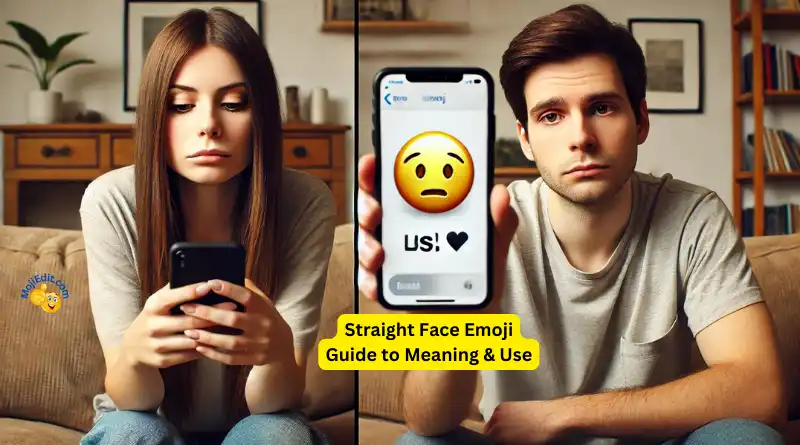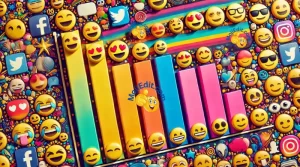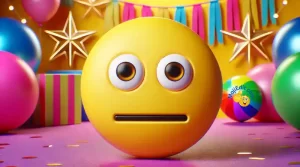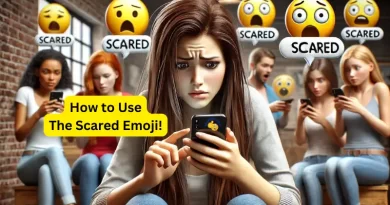Straight Face Emoji: A Symbol of Neutrality and Indifference
Introduction
While vibrant and exaggerated expressions dominate most digital keyboards, the straight face emoji holds a unique position. It is subtle, understated, and often conveys a range of complex emotions that are otherwise difficult to articulate.
Key Takeaways
-
Unique Position: The straight face emoji (😐) stands out among the vibrant and exaggerated expressions, conveying complex emotions subtly and understatedly.
-
Anatomy and Design: Officially known as the neutral face emoji, it features a yellow face with open eyes, a straight line for a mouth, and flat eyebrows, perfectly designed to convey a deadpan, emotionless expression.
-
History and Standardization: Introduced in Unicode version 6.1 in January 2012, and included in the Emoji 1.0 release, the straight face emoji quickly became a staple in digital communication with the Unicode code point U+1F610.
-
Cultural Nuances: Its interpretation varies across cultures, from politeness in Eastern cultures to humor and sarcasm in Latin American cultures, highlighting its versatility.
-
Usage and Popularity: With over 5 billion emojis sent daily on platforms like Facebook Messenger, the straight face emoji is frequently used to convey neutrality, mild irritation, and indifference without being misinterpreted.
-
Combination for Nuance: Combining the straight face emoji with others (like 😕, 😒, or 🤔) enhances the expressiveness of digital conversations, allowing for more nuanced emotional communication.
-
Related Emojis: Understanding similar emojis, such as 😑 (expressionless face), 😶 (face without mouth), and 😒 (unamused face), can help convey a broader range of emotions.
-
Practical Tips: Use the straight face emoji effectively in various scenarios—from conveying mild irritation to maintaining a professional tone in conversations.
-
Cultural Impact: Recognizing how different cultures interpret this emoji can improve your digital communication, ensuring your intended message is clear and appropriate.
By mastering the use of the straight face emoji and its related symbols, you can navigate the complexities of digital communication with ease and confidence.
The Anatomy of the Straight Face Emoji
What is the Straight Face Emoji?
The straight face emoji, officially known as the neutral face emoji, depicts a yellow face with open eyes, a straight line for a mouth, and neutral, flat eyebrows. The expressionless face is designed to convey a deadpan sense, devoid of any strong emotion, making it a versatile tool in digital communication.
The Neutral Face Emoji: A Closer Look
The neutral face emoji is not exaggerated; it is calm and composed, with a closed mouth and open eyes. It represents a neutral sentiment, perfect for situations where one wants to convey mild irritation, apathy, or neutrality without leaning towards a positive or negative context.
History of the Straight Face Emoji
The straight face emoji (😐), also known as the neutral face emoji, is a relatively recent addition to the emoji family, but it has quickly become a staple in digital communication. Its journey from concept to our keyboards is an interesting one.
Unicode and Emoji Versions
Unicode Consortium:
The Unicode Consortium is a non-profit organization that oversees the development and maintenance of the Unicode Standard, which encodes text characters for all the world’s writing systems, including emojis.
Version and Year Added:
The straight face emoji was introduced in Unicode version 6.1, which was released in January 2012. This version included a significant number of new emoji characters, reflecting the growing importance of emojis in digital communication.
When Added as an Emoji:
The straight face emoji was officially added to the emoji keyboard in 2012, as part of the Emoji 1.0 release. This release marked a major milestone in the standardization of emojis, ensuring consistency across different platforms and devices.
Unicode Code Point:
The straight face emoji is represented by the Unicode code point U+1F610. This hexadecimal code is part of the “Emoticons” block, which contains a wide range of emoji characters.
Timeline Summary
| Event | Details |
|---|---|
| Unicode Consortium | Oversees the Unicode Standard and emojis |
| Version Added | Unicode 6.1 |
| Year Added | 2012 |
| Added to Emoji Keyboard | Emoji 1.0 release |
| Unicode Code Point | U+1F610 |
The straight face emoji has since become an essential tool for conveying neutrality, mild irritation, and indifference in digital communication. Its standardized appearance across platforms has helped ensure that its meaning remains consistent, making it a reliable choice for expressing subtle emotions.
Usage and Popularity
A Tool for Subtlety
In an age where over one in five tweets include an emoji (21.54%), the straight face emoji stands out as a symbol of subtlety. While emojis like 😂 (Face With Tears of Joy) dominate Twitter as the most used emoji, the neutral face emoji offers a counterbalance by providing a way to express less intense emotions.
Daily Usage
With 5 billion emojis sent daily on Facebook Messenger, including over 900 million sent without any accompanying text, the neutral face emoji finds its place in conveying neutral sentiments. It is especially useful in situations where one wants to maintain a calm and composed demeanor, without the risk of being misinterpreted as overly enthusiastic or disinterested.
Copy and Paste the Straight Face Emoji
Want to add a touch of neutrality or mild irritation to your messages or posts? You can easily copy the straight face emoji (😐) and paste it wherever you need a neutral expression. Just follow these simple steps:
- Click the “Copy” button below to copy the straight face emoji to your clipboard.
Emoji Copied! 😐 - Go to the place where you want to use the emoji and right-click on the text field.
- Choose “Paste” from the context menu, or simply use the keyboard shortcut Ctrl + V (Windows) or Cmd + V (Mac) to paste the emoji.
And voilà! You’re all set to add some subtlety and nuance to your conversations.
Straight Face Emoji in Action!
Using the straight face emoji in actual text conversations can help illustrate its versatility and subtlety. Here are a few scenarios where this emoji can come in handy:
Example 1: Mild Irritation Friend: “Sorry, I can’t make it tonight. Something came up.” You: “😐 That’s the third time this week.”
In this example, the straight face emoji conveys mild irritation without coming across as overly confrontational.
Example 2: Expressing Apathy Coworker: “We have another meeting at 3 PM today.” You: “😐 Another one? Didn’t we just have one this morning?”
Here, the emoji is used to show a lack of enthusiasm or interest in the additional meeting.
Example 3: Deadpan Humor Friend: “I just ate the spiciest pepper in the world. I think I might die.” You: “😐 You always say that.”
The straight face emoji adds a layer of deadpan humor, highlighting the exaggerated nature of the friend’s statement.
Example 4: Neutral Reaction Classmate: “I think the new teacher is really strict.” You: “😐 I haven’t noticed anything different.”
In this context, the emoji is used to express a neutral or indifferent opinion about the new teacher.
Example 5: Subtle Disappointment Sibling: “I borrowed your favorite book and accidentally spilled coffee on it.” You: “😐 Great. Just what I needed.”
This response conveys subtle disappointment without escalating the situation, maintaining a calm tone.
Using the straight face emoji in these ways can help you navigate various social interactions with nuance and clarity, making it a valuable addition to your digital communication toolkit.
Emotional and Contextual Nuances
Conveying Mild Irritation and Apathy
The neutral face emoji is perfect for conveying mild irritation or a deadpan sense of humor. It can be used to represent mild annoyance without escalating the situation, making it ideal for professional or delicate conversations.
Expressing Confusion and Indifference
Its neutral expression and flat demeanor can convey a sense of “meh,” reflecting boredom or a lack of enthusiasm. It is a go-to emoji for expressing feelings of discontent or frustration without coming across as too harsh.
Cultural and Demographic Trends
Age and Gender Differences
Statistics show that 86% of emoji users on Twitter are 24 or younger, and 57% of those users are women. So the neutral face emoji is most likely popular among younger demographics who often use it to convey a variety of nuanced emotions, from mild irritation to subtle humor.
Social Media and Messaging
In social media and messaging platforms, emojis play a big role in enhancing communication. More than 700 million emojis are used in Facebook posts every day, and the neutral face emoji is frequently employed to add context to posts, comments, and messages that require a balanced emotional tone.
The Emotional Impact of the Straight Face Emoji
Enhancing Digital Conversations
The neutral face emoji helps prevent misinterpretations and maintains a composed and calm interaction, especially in potentially sensitive conversations.
Bridging Emotional Gaps
The neutral face emoji helps bridge the emotional gap in text-based communication. By providing a clear visual representation of mild irritation, apathy, or neutrality, it allows users to express their feelings more accurately, enhancing the overall quality of the conversation.
Related Straight Face Emojis
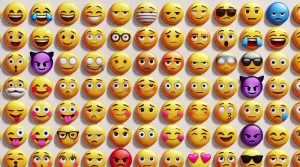
The straight-face emoji (😐) is part of a broader family of emojis that convey similar expressions of neutrality, indifference, or mild irritation. Understanding these related emojis can enhance your digital communication by providing a range of nuanced reactions. Here are some commonly used related emojis:
😑 Expressionless Face Emoji
The expressionless face emoji (😑) features a neutral mouth and closed eyes. It often represents deeper levels of frustration or exasperation compared to the straight face emoji. This emoji is perfect for situations where you’re feeling particularly unenthused or irritated.
😶 Face Without Mouth Emoji
The face without mouth emoji (😶) depicts a neutral face without a mouth, symbolizing speechlessness or a lack of words. It can be used to express that you’re at a loss for words, whether due to shock, awkwardness, or an inability to respond.
😒 Unamused Face Emoji
The unamused face emoji (😒) shows a slightly frowning mouth and eyes looking to the side. It conveys dissatisfaction, skepticism, or annoyance. This emoji is often used to react to something unimpressive or to express mild disapproval.
😐😕 Combination
Combining the straight face emoji with the confused face emoji (😕) can amplify the sense of mild confusion or uncertainty. This combination is useful when you want to express that you’re unsure about a situation while maintaining a neutral stance.
😐😒 Combination
Pairing the straight face emoji with the unamused face emoji can underscore a stronger sense of irritation or boredom. This combination effectively conveys a more pronounced disinterest or dissatisfaction.
🤔 Thinking Face Emoji
The thinking face emoji (🤔) shows a face with a hand on its chin, furrowed eyebrows, and a contemplative expression. It’s used to indicate deep thought or consideration. Combining it with the straight face emoji can convey a shift from neutrality to thoughtful consideration.
Summary Table
| Emoji | Description | Use Case |
|---|---|---|
| 😑 Expressionless Face | Neutral mouth, closed eyes | Deep frustration or exasperation |
| 😶 Face Without Mouth | Neutral face, no mouth | Speechlessness, shock, or awkwardness |
| 😒 Unamused Face | Slight frown, eyes looking to the side | Dissatisfaction, skepticism, mild disapproval |
| 😐😕 Combination | Straight face + confused face | Mild confusion, uncertainty |
| 😐😒 Combination | Straight face + unamused face | Stronger irritation or boredom |
| 🤔 Thinking Face | Hand on chin, furrowed brows, contemplative look | Deep thought or consideration |
These related emojis can help you convey a wider range of emotions and reactions, making your digital communication more expressive and nuanced.
Wrapping Up
Frequently Asked Questions and Answers
The straight face emoji, also known as the neutral face emoji, represents a lack of emotion or indifference. It conveys a neutral, deadpan expression, often used to show mild irritation, apathy, or a sense of being unimpressed.
You should use the straight face emoji when you want to express neutrality, indifference, or mild irritation. It’s perfect for situations where you need to keep your emotions in check or want to convey a “meh” reaction.
Yes, similar emojis include the expressionless face emoji (😑), the unamused face emoji (😒), and the face with rolling eyes emoji (🙄). These emojis also convey neutrality, mild irritation, or skepticism.
Yes, the straight face emoji is considered gender-neutral. It does not have any features that are specifically associated with a particular gender, making it versatile for use by anyone.
The straight face emoji can be used to convey sarcasm. Its neutral expression can highlight the absurdity of a statement, adding a layer of dry humor or irony to your message.

